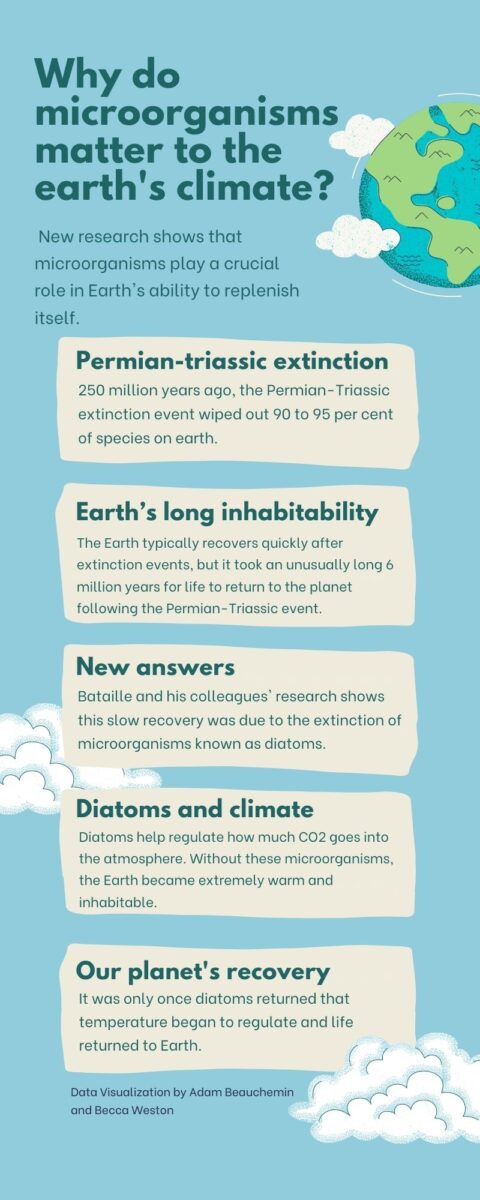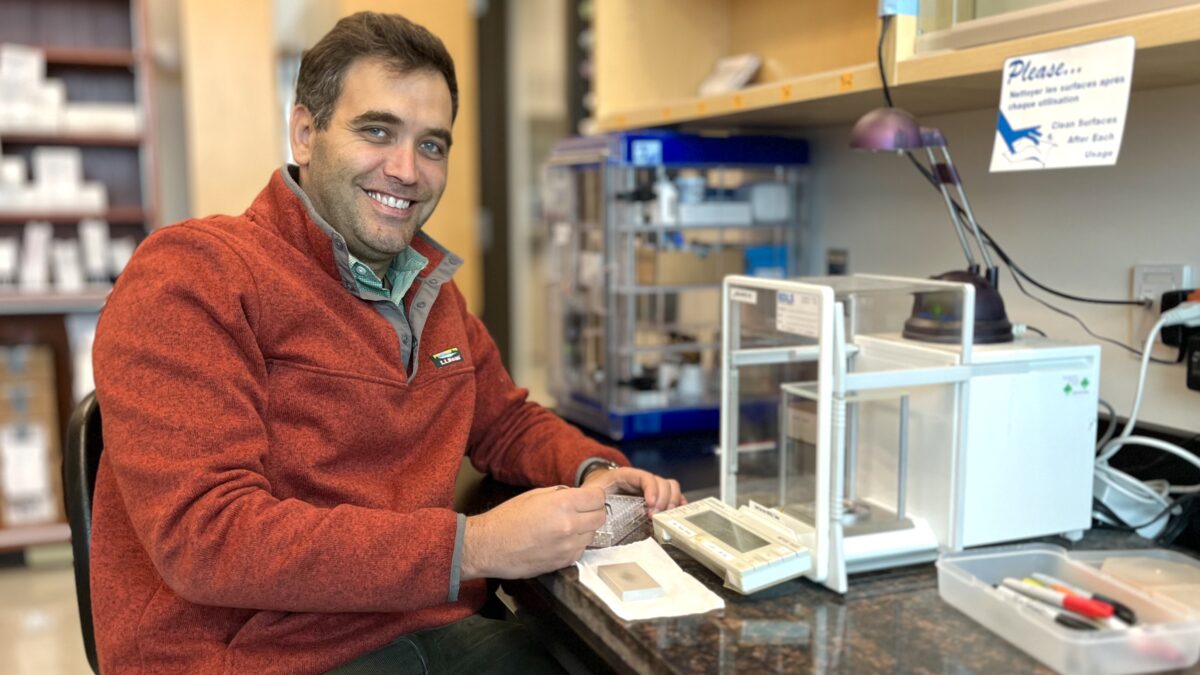More than 250 million years ago, life on Earth nearly disappeared.
In an event known as the Permian-Triassic extinction, about 95 per cent of all the species on the planet were wiped out. This isn’t the only extinction event in Earth’s long history, but it’s one that’s been particularly puzzling to scientists.
“Usually a mass extinction event happens — a meteorite hits or there’s a big volcanic eruption — and things disappear, but then they recover relatively fast,” says Clément Bataille, an associate professor in the University of Ottawa’s department of earth and environmental sciences. “What happened in this case is that for six million years after this mass extinction, nothing recovered.”
For decades, researchers have been trying to figure out why it took so long for life to return to Earth after the catastrophic Permian-Triassic extinction. Now, new research from Bataille and his colleagues suggests that this protracted recovery happened because of the extinction of important microorganisms.
Seeking answers
Bataille, along with Prof. Xiao-Ming Liu from the University of North Carolina and PhD student Cheng Cao (now a postdoctoral fellow at Nanjing University), set out to find answers to this question more than six years ago. Their conclusions appeared last month in the journal Nature Geoscience, in an article co-authored with six other researchers from the U.S., China and Denmark, along with an accompanying editorial highlighting the importance of their findings.
Bataille uses isotopes in his research to trace things such as the migration of animals. By doing this, it’s easier to understand how pollution can be traced back to its sources.
Initially, the team believed the answer to their questions could be found in a process called weathering. Earth has maintained its habitability by regulating how much carbon dioxide ends up in the air through the process of weathering.
‘The results were so surprising. I got those results six years ago, but we didn’t have the framework to explain the results.’
— Prof. Clément Bataille, earth scientist, University of Ottawa
“When we started the study, we wanted to say, OK, maybe something happened with this weathering process that was affecting the climate,” said Batatille.
However, when they looked at the mass extinction, Bataille and the other researchers realized there had to be something else that was making isotope values so low.
“The results were so surprising. I got those results six years ago, but we didn’t have the framework to explain the results,” says Bataille, adding that his team had to wait for the field to evolve before they could confirm their suspicions.
They found that the opposite reaction was happening, creating reverse weathering. This happens when carbon is released into the atmosphere and is not trapped by rock, explaining why isotope values decreased.
Bataille explains that our oceans today have very little to no silicon in them because one little microorganism, known as a diatom, uses almost all of the silicon found in oceans to make its shell.
“In the past, this microorganism had not evolved yet and there were some other micro-organisms that were capable of making silicone shells called radiolarians,” said Bataille. “But they (radiolarians) disappeared at the moment of this big mass extinction — they were one of the first microorganisms to disappear.”
With this microorganism gone, silicon continued to build up and began to form into clay.
“Instead of trapping a molecule of CO2 in the ocean, it’s actually releasing a molecule of CO2,” said Bataille.
Earth couldn’t get back to a normal state of self-regulation, potentially explaining why it took so long for life to return to the planet. This process is similar to the greenhouse effect, in which CO2 is released into the atmosphere and heats up the planet.
“Only because this microorganism disappeared, one little microorganism or one little group of microorganisms that were able to lock everything, and to keep the old cycles in check basically, are not there anymore,” said Bataille.
Bataille and his colleagues’ research potentially fills in many knowledge gaps about the era, says Hana Jurikova, a research fellow at the University of St. Andrews in Scotland, who studies the co-evolution of climate, environment and life on Earth. Jurikova also wrote an accompanying editorial for the study. “It definitely brings us forward,” says Jurikova. “They’ve done the work that hadn’t been done and was needed.”
This research does two important things to advance the field, she says.
‘When I saw this (study), I was really excited, because I feel like it was a really important record that we’ve been missing for a long time.’
— Hana Jurikova, research fellow, University of St. Andrews, Scotland
First, it provides scientists with a new lithium-isotope record that spans the whole of the Permian period, something that’s not easy to produce.
“You need to be very careful when it comes to picking your samples and screening them and also making sure that all of your laboratory methods are really sound,” says Jurikova. “So, when I saw this (study), I was really excited, because I feel like it was a really important record that we’ve been missing for a long time.”
This is also the first piece of evidence that suggests that the process of reverse weathering was happening in the Permian period, says Jurikova.
Now, it will be up to researchers to continue to build upon and prove the findings of this study. “I think it’s really exciting evidence that still needs to be proved and hopefully further studies will kind of prove and follow up on that,” says Jurikova.

Small but mighty
One important thing this study shows is how interconnected the planet is, says Bataille. Even small and seemingly insignificant lifeforms, like diatoms, can heavily influence the climate and habitability of the planet.
“I mean, we would not be here, we would not be able to respire our oxygen if it was not for trees or cyanobacteria that evolved millions or billions of years ago. Our oceans cannot be habitable without those little diatoms that we have currently, and we don’t think about them — but they actually regulate all those biochemical cycles,” he says.
Attention is paid to larger organisms that go extinct, says Bataille, but small micro-organisms that are crucial to our own survival are often overlooked in conversations about conservation. This research is just another example of why it’s important to care for our planet and pay attention to small organisms that can have massive impacts, he says.
While Bataille and his colleagues’ research furthers our understanding of Earth, it also helps us better understand the workings of extraterrestrial planets. “There are many reasons for staring at past climates, and one of them is simply to understand the habitability of planets,” Bataille says.
By having a comprehension of the history of habitability on our planet, we may more easily determine habitability elsewhere in the universe, Bataille says.
By using powerful new tools like the James Webb Space Telescope, scientists can look at the atmospheric composition of other planets and compare them to the atmosphere of Earth at different points in history. If a planet’s atmosphere is mostly composed of CO2, we can estimate that it is acting similarly to the Earth when its atmosphere was mostly composed of CO2, says Bataille.
“So this atmosphere tells you a lot about where the planet is at in terms of habitability, because there is a very clear sequence of events in the history of our planets that lead to life, that lead to habitability,” he says.
What’s next
Bataille started on this project as a postdoctoral scholar in 2016, and since then his research interests have changed.
He’s still using isotopes to understand life on our planet in the distant past, but now he’s tracing animal migration patterns from millions of years ago. This new research may help us better understand animal extinction, says Bataille.
“I think it’s a nice view of the independence that profs have,” says Bataille, adding that he’s able to work on topics that interest him but also hold relevance to important discussions on conservation and climate.




